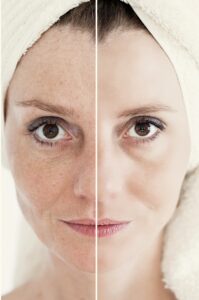Unveiling the Impact of Sun Rays on Your Skin
 In the eternal interplay between the sun and our skin, understanding the effects of ultraviolet radiation is key to cultivating a sun-safe lifestyle. There is more to sunlight than meets the eye, and the trio of UVA, UVB, and UVC rays each brings a unique set of consequences for our skin. From the deep penetration of UVA rays, leading to premature aging, to the burning impact of UVB rays causing sunburn and contributing to skin cancers, and the mercifully filtered UVC rays, each play a distinct role in shaping our skin’s health. Let’s unravel the science behind these rays, exploring their reach, the damage they can inflict, and, most importantly, how to shield our skin from their potential harm
In the eternal interplay between the sun and our skin, understanding the effects of ultraviolet radiation is key to cultivating a sun-safe lifestyle. There is more to sunlight than meets the eye, and the trio of UVA, UVB, and UVC rays each brings a unique set of consequences for our skin. From the deep penetration of UVA rays, leading to premature aging, to the burning impact of UVB rays causing sunburn and contributing to skin cancers, and the mercifully filtered UVC rays, each play a distinct role in shaping our skin’s health. Let’s unravel the science behind these rays, exploring their reach, the damage they can inflict, and, most importantly, how to shield our skin from their potential harm
UVA Rays, The Aging Rays
UVA rays have the longest wavelength and can penetrate deepest into the skin, reaching the dermis—the second layer of the skin.  UVA rays are primarily responsible for premature aging. They can lead to the formation of wrinkles, fine lines, and age spots by breaking down collagen and elastin fibers in the skin.
UVA rays are present consistently throughout the day and can penetrate windows, making them a constant concern even when indoors, or driving 
While UVA rays are less likely to cause sunburn, they play a role in the development of skin cancers, particularly melanoma. 
UVB Rays, The Burning Rays
UVB rays have a shorter wavelength and primarily affect the outermost layer of the skin, the epidermis. UVB rays are the main cause of sunburn. They directly damage the DNA in skin cells, triggering the body’s inflammatory response, leading to redness and pain. They also stimulate the production of melanin, causing the skin to tan. Prolonged exposure can result in uneven pigmentation and an increased risk of skin cancer. UVB rays are a significant contributor to the development of melanoma and non-melanoma skin cancers, such as basal cell carcinoma and squamous cell carcinoma.
UVC Rays, Filtered by the Atmosphere
UVC rays have the shortest wavelength and are typically filtered out by the Earth’s atmosphere, so they do not reach the surface. UVC rays are encountered in certain artificial sources like welding torches, germicidal lamps, and some industrial processes. Direct exposure to UVC rays can cause skin and eye damage. However, the natural filtering of the atmosphere protects us from significant UVC exposure from the sun.
Preventing Damage
Broad-spectrum sunscreens protect against both UVA and UVB rays. Look for products with SPF (Sun Protection Factor) to shield against UVB and additional ingredients like zinc oxide or avobenzone for UVA protection. Tinted mineral sunscreens are favorable in that they form a protective, reflective shield on the skin’s surface, and tend to prevent hyperpigmentation. One particular brand, Intellishade by Revision Skin Care is highly recommended for its cosmetic elegance, sun protection factor and anti aging properties.
Wearing protective clothing, including wide-brimmed hats and sunglasses, helps minimize direct exposure to UV rays. Seeking shade during peak sunlight hours reduces overall UV exposure.
Understanding the distinct ways UVA, UVB, and UVC rays affect the skin is crucial for implementing effective sun protection measures and maintaining skin health.


